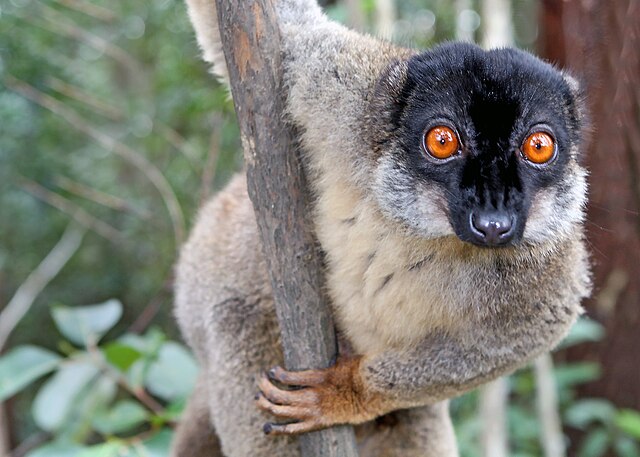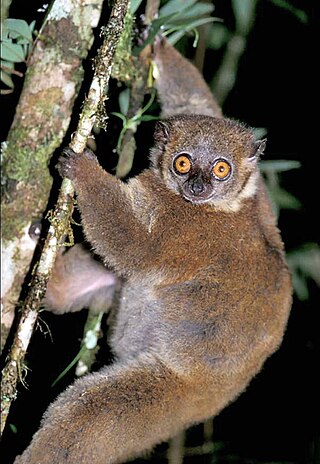Portal:Primates
Portal:Primates
 A primate is a member of the biological order Primates, the group that contains lemurs, the aye-aye, lorisids, galagos, tarsiers, monkeys, and apes, with the last category including great apes. With the exception of humans, who inhabit every continent on Earth, most primates live in tropical or subtropical regions of the Americas, Africa and Asia. Primates range in size from the 30-gram (1 oz) pygmy mouse lemur to the 200-kilogram (440 lb) mountain gorilla. According to fossil evidence, the primitive ancestors of primates may have existed in the late Cretaceous period around 65 mya (million years ago), and the oldest known primate is the Late Paleocene Plesiadapis, c. 55–58 mya. Molecular clock studies suggest that the primate branch may be even older, originating in the mid-Cretaceous period around 85 mya. Primates exhibit a wide range of characteristics. Some primates do not live primarily in trees, but all species possess adaptations for climbing trees. Locomotion techniques used include leaping from tree to tree, walking on two or four limbs, knuckle-walking, and swinging between branches of trees (known as brachiation). Primates are characterized by their large brains relative to other mammals. These features are most significant in monkeys and apes, and noticeably less so in lorises and lemurs. Many species are sexually dimorphic, which means males and females have different physical traits, including body mass, canine tooth size, and coloration.
Humans are bipedal primates belonging to the species Homo sapiens (Latin: "wise man" or "knowing man") in Hominidae, the great ape family. They are the only surviving member of the genus Homo. Humans have a highly developed brain, capable of abstract reasoning, language, introspection, and problem solving. This mental capability, combined with an erect body carriage that frees the arms for manipulating objects, has allowed humans to make far greater use of tools than any other species. Mitochondrial DNA and fossil evidence indicates that modern humans originated in Africa about 200,000 years ago. Humans now inhabit every continent and low Earth orbit, with a total population of over 6.7 billion as of September 2009.
Like most higher primates, humans are social by nature. However, humans are uniquely adept at utilizing systems of communication for self-expression, the exchange of ideas, and organization. Humans create complex social structures composed of many cooperating and competing groups, from families to nations. Social interactions between humans have established an extremely wide variety of values, social norms, and rituals, which together form the basis of human society. Humans have a marked appreciation for beauty and aesthetics which, combined with the human desire for self-expression, has led to cultural innovations such as art, literature and music. Humans are noted for their desire to understand and influence their environment, seeking to explain and manipulate natural phenomena through science, philosophy, mythology and religion. This natural curiosity has led to the development of advanced tools and skills, which are passed down culturally; humans are the only extant species known to build fires, cook their food, clothe themselves, and use numerous other technologies.  The white-fronted capuchin, Cebus albifrons, is a species of capuchin monkey, a type of New World primate, found in seven different countries in South America: Bolivia, Brazil, Colombia, Venezuela, Ecuador, Peru, and Trinidad and Tobago. The species is divided into several different subspecies, though the specific divisions are uncertain and controversial.  Data Deficient (IUCN 3.1)|Data Deficient The small-toothed sportive lemur (Lepilemur microdon), or small-toothed weasel lemur, is a primate species in the family Lepilemuridae that—like all lemurs—is endemic to Madagascar. The species lives in dense rainforest in southeastern Madagascar, and can be found in Ranomafana National Park and Andringitra National Park. As its name implies, some of its teeth are smaller than those in other sportive lemurs. It is relatively large for a sportive lemur, and is difficult to visually distinguish from the weasel sportive lemur. The species weighs between 0.9 and 1.2 kg (2.0 and 2.6 lb) and measures 55 to 64 cm (22 to 25 in) from head to tail. Its fur is mostly reddish-brown or chestnut color, with a dark stripe running from its head down its back. Its underside and neck are lighter in color. Like other sportive lemurs, it is nocturnal, sleeping in concealed tangles of vegetation as well as tree holes. The small-toothed sportive lemur is solitary and eats leaves, fruits, and flowers. Due to recent taxonomic changes and a lack of clarity about its population size and range, it is listed as "Data Deficient" by the International Union for Conservation of Nature (IUCN). It is also protected from international commercial trade under CITES Appendix I. Its primary threats are habitat loss to slash and burn agriculture and hunting. 

Discover Wikipedia using portals |
















